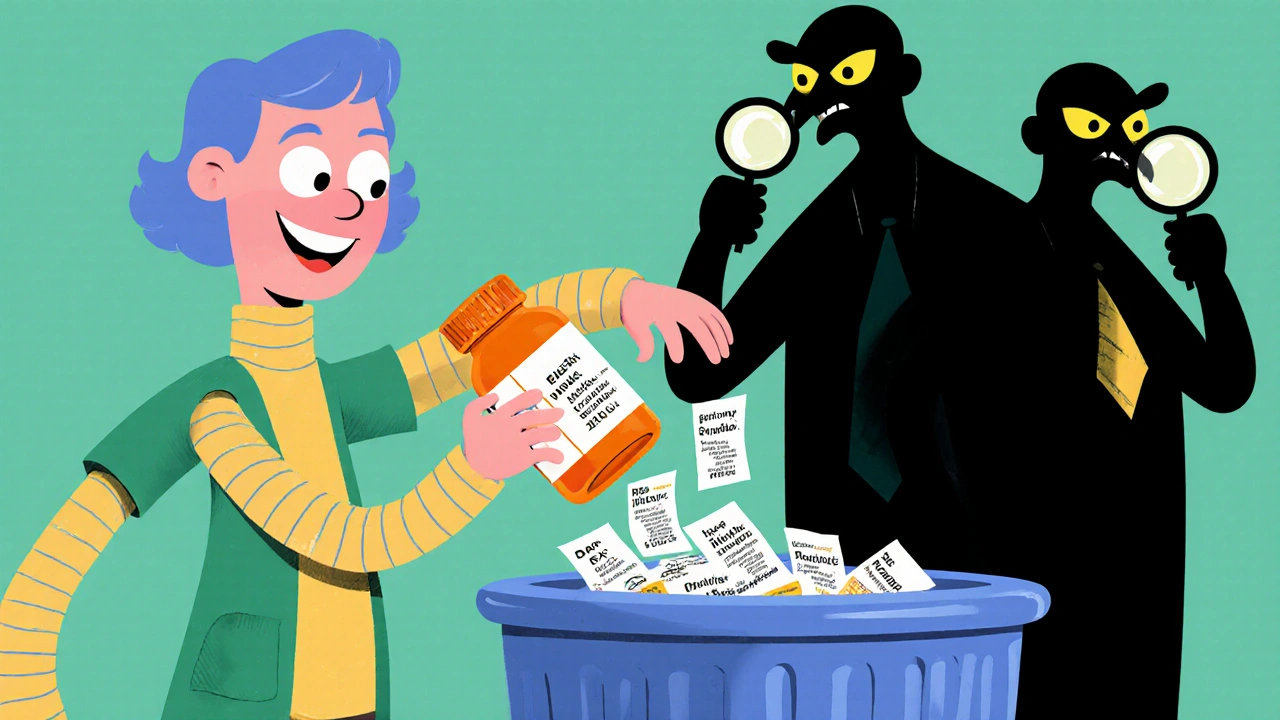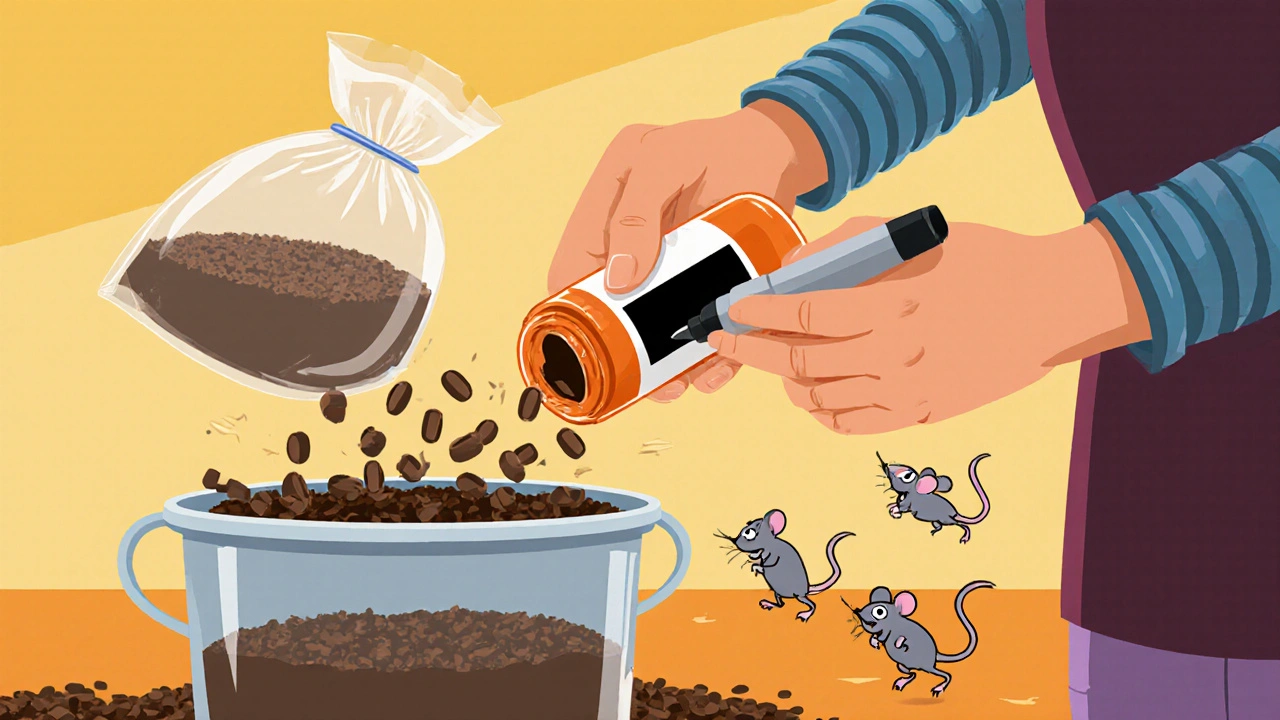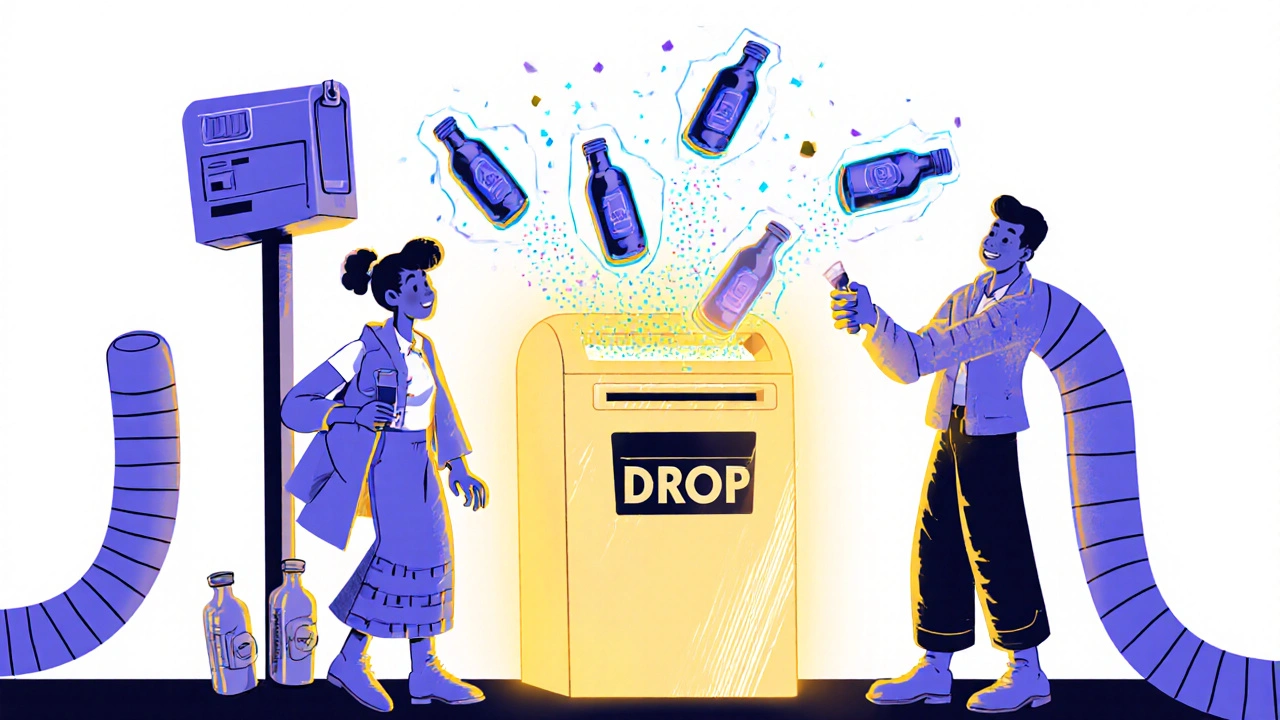
Throwing away old pills might seem like a simple chore, but if you don’t handle the packaging right, you’re leaving your personal health data wide open. Prescription bottles don’t just hold medicine-they hold your name, address, doctor’s name, diagnosis, and even your insurance number. All it takes is one curious trash picker or a data thief going through your bins to turn that into identity theft, fraudulent prescriptions, or insurance fraud. And it’s happening more than you think.
Why Your Prescription Bottle Is a Goldmine for Identity Thieves
Most people don’t realize that a single empty pill bottle contains enough information for someone to steal your identity. The label includes your full name, home address, the prescribing doctor’s name, the pharmacy’s contact info, your date of birth (sometimes), and the Rx number tied to your insurance file. That’s not just a label-it’s a roadmap to your medical history and financial accounts.
In 2022, the Mayo Clinic found that 68% of patients didn’t remove personal details from prescription containers before tossing them. A 2021 study in the Journal of the American Pharmacists Association showed 42% of discarded bottles still had readable labels. That’s nearly half the time, someone could walk away with your data and use it to get prescriptions filled in your name-or sell your info on the dark web.
The Health Insurance Portability and Accountability Act (HIPAA) requires healthcare providers to protect your Protected Health Information (PHI), even after you’ve stopped using the medication. That means the responsibility doesn’t end when you leave the pharmacy. You’re the last line of defense.
The Safe Way to Dispose of Medications: FDA’s 5-Step Guide
The FDA recommends a clear, five-step process for disposing of unused or expired medications at home. It’s not complicated, but skipping even one step can leave your privacy at risk.
- Take pills out of the original container. Don’t just toss the bottle. Empty the pills into a sealable bag or container.
- Mix them with something unappealing. Use cat litter, coffee grounds, or dirt. This makes the pills unattractive and unusable. Don’t use food-it could attract animals or kids.
- Seal the mixture in a disposable container. Use a plastic tub, jar, or even a ziplock bag. Tape it shut to prevent spills.
- Remove or destroy all personal info on the bottle. This is the most critical step. Use a permanent marker to black out your name, address, Rx number, and doctor’s info. Or scrape it off with a knife. Duct tape over the label works too.
- Throw the container and the sealed mixture in the trash. Don’t recycle the bottle-most recycling programs won’t accept it after it’s held medication.
Doing this takes about five minutes per bottle. It’s not glamorous, but it’s the difference between your data staying safe or ending up in the wrong hands.
When to Flush Medications: The FDA Flush List
Not all medications are safe to throw away. Some are so dangerous if accidentally ingested-especially by children or pets-that the FDA says you should flush them immediately. As of May 2024, there are 15 medications on the official Flush List. These include powerful opioids like fentanyl patches, certain painkillers like oxycodone, and seizure medications like diazepam.
If your medication is on this list, don’t wait for a take-back program. Take the pills out of the bottle, flush them down the toilet right away, then destroy the label as usual. The FDA created this list because the risk of accidental overdose outweighs environmental concerns in these rare cases.
Still unsure? Check the FDA’s website or use the DisposeRx app (free on iOS and Android). It scans your bottle’s barcode and tells you whether to flush, take to a drop-off, or dispose at home.
Best Privacy Protection: Drug Take-Back Programs
If you want the highest level of privacy and safety, use a drug take-back program. These are run by the DEA, local police departments, or pharmacies like Walgreens, CVS, and Rite Aid. They collect unused meds in secure drop-boxes and destroy them under federal supervision.
During the April 2024 National Prescription Drug Take Back Day, over 821,000 pounds of medications were collected at 6,000 locations across the U.S. No one sees your name. No one touches your label. The whole process is anonymous and secure.
Most chain pharmacies now offer year-round drop-off bins. You don’t need an appointment. Just walk in, drop your bottles in the box, and leave. No questions asked. According to a 2024 Pharmacy Times poll, 89% of people who used these programs felt “very confident” their privacy was protected.

Mail-Back Kits: A Convenient Alternative
Not everyone lives near a drop-off location. Mail-back kits are a great middle ground. Companies like Walgreens and DisposeRx sell pre-paid envelopes you can order online or pick up in-store. You put your meds in, seal it, and drop it in the mailbox.
These kits cost between $2.99 and $6.99, and they’re FDA-approved. The envelopes are tamper-proof and go directly to licensed disposal facilities. Your label stays inside the sealed container, so no one ever sees your personal info. It’s like sending a letter-but instead of a note, you’re sending your old pills to be destroyed safely.
Pharmaceutical Deactivation Pouches: One-Step Privacy
DisposeRx pouches are gaining popularity because they do two things at once: neutralize the medication and destroy the label. You pour your pills into the pouch, add water, shake it, and toss it in the trash. The activated carbon inside breaks down the drugs, and the pouch’s design makes labels unreadable.
Each pouch costs about $1.50-$3.00. They’re especially helpful for seniors or people with mobility issues. One Yelp reviewer called it “finally a simple privacy solution.” The downside? You still need to remove the label from the original bottle before using the pouch. But it cuts down on steps and reduces mess.
What NOT to Do
Don’t flush medications unless they’re on the FDA Flush List. It pollutes water systems and harms aquatic life. The EPA estimates 3.2 million pounds of pharmaceuticals enter U.S. waterways every year.
Don’t just throw the bottle in the recycling bin. Pharmacies don’t recycle pill bottles because they’ve held controlled substances. Most recycling centers will reject them.
Don’t rely on “scratching off” with a pencil or eraser. Ink from prescription labels is designed to resist fading. Only a permanent marker, tape, or physical removal will do.

Real Consequences: Stories from the Front Lines
One Reddit user shared how someone used their discarded oxycodone bottle to get more pills under their name. They later found $1,200 in fraudulent insurance charges. Another user in a Kaiser Family Foundation survey said they didn’t know their prescription label had enough info to steal their identity-until they got a call from their bank about suspicious activity.
These aren’t rare cases. The 2023 IBM Cost of a Data Breach Report found that healthcare records involving medication info cost $498 per record to fix. That’s more than credit card fraud. And it’s all preventable.
What’s Changing in 2025 and Beyond
Regulators are catching up. In March 2024, the HHS Office for Civil Rights announced 17 new settlements totaling $4.2 million against healthcare providers for improper PHI disposal. The DEA is expanding take-back locations. And by 2027, 40% of major pharmacies are expected to install smart kiosks that automatically erase labels and destroy pills in one step.
Meanwhile, the bipartisan Safe Drug Disposal Act of 2024 is pushing for $50 million in federal funding to expand free, privacy-protected disposal options nationwide. The goal? Make safe disposal as easy as recycling.
Final Checklist: Your Privacy Protection Plan
- ✅ Always remove pills from original bottles
- ✅ Mix with cat litter or coffee grounds
- ✅ Seal in a non-transparent container
- ✅ Black out or remove all personal info with a permanent marker or tape
- ✅ Check the FDA Flush List-flush only if required
- ✅ Use take-back bins when available (free and safest)
- ✅ Use mail-back kits if no drop-off is nearby
- ✅ Never recycle pill bottles
- ✅ Never flush unless it’s on the official list
It’s not about being paranoid. It’s about being smart. Your health data is valuable. Protect it like you protect your password or your Social Security number. One extra minute of effort can save you months of stress, money, and legal headaches.
Can I just throw my old pills in the trash without doing anything else?
No. Throwing pills in the trash without removing personal info or mixing them with an unappealing substance leaves your data exposed and makes the medication accessible to others. This is the most common mistake-and the most dangerous. Always follow the FDA’s five-step process.
Do I need to remove the label from the pill bottle?
Yes. The label contains your name, address, doctor’s name, and insurance details. Even if you’ve emptied the bottle, the label is still a privacy risk. Scratch it out with a permanent marker, cover it with duct tape, or peel it off if possible. Don’t rely on water or soap-it won’t work.
Are drug take-back programs really safe for my privacy?
Yes. DEA-authorized take-back locations collect medications anonymously. Your name and personal info are never seen or recorded. The pills are destroyed under federal supervision. This is the most secure option available.
What if I can’t find a take-back location near me?
Use a mail-back kit or a deactivation pouch. Both are FDA-approved and designed to protect your privacy. Mail-back kits cost under $7 and can be ordered online or picked up at pharmacies. Pouches are sold in packs at most drugstores and work in minutes.
Is it safe to flush medications down the toilet?
Only if the medication is on the FDA’s Flush List. This list includes powerful opioids and seizure meds that pose a serious risk if accidentally ingested. For all other medications, flushing harms the environment and is not recommended. Always check the label or use the DisposeRx app to confirm.
Why can’t I recycle my old pill bottles?
Pill bottles are considered contaminated because they held controlled substances. Most recycling centers won’t accept them, and even if they did, your personal info might still be readable. Always destroy the label and throw the bottle in the trash.
How do I know if a medication is on the FDA Flush List?
Check the FDA’s official website or use the free DisposeRx app. You can scan the barcode on the bottle, and the app will tell you whether to flush, take to a drop-off, or dispose at home. The list was updated in May 2024 and currently includes 15 medications.
Is it worth paying for a mail-back kit or deactivation pouch?
Yes-if you value your privacy. A $3 pouch or $6 mailer is a small price to pay compared to the cost of identity theft, which averages $498 per record. These tools make disposal easier, safer, and more reliable than DIY methods.
Comments (8)
-
Katy Bell November 24, 2025
I used to just toss my old pill bottles in the recycling until I saw a news segment about someone getting prescribed opioids under my name. I now use permanent marker on every label-black out everything like I’m hiding a secret. It’s weirdly satisfying. I even keep a Sharpie in my bathroom drawer now. No more excuses.
Also, cat litter? Genius. My cat hates it when I mix his food with old meds, but he’s too lazy to dig through the trash anyway. Win-win.
-
Ragini Sharma November 25, 2025
omg i just threw away my amoxicillin bottle last week and didnt even think about the label lmao my name is ragini sharma and my doc is dr. khan and my ins co is unitedhealthcare-someone could totally open a fake pharmacy account with that. im going back to the trash right now with duct tape. thanks for the wake up call 😅
-
Linda Rosie November 26, 2025
Proper disposal of pharmaceuticals is a public health imperative. The legal and ethical obligations under HIPAA extend beyond institutional responsibility. Individual action is non-negotiable.
-
Vivian C Martinez November 26, 2025
This is such an easy fix-five minutes per bottle, and you’re protecting your identity. Seriously, if you can brush your teeth, you can black out a label. You’re worth more than a data breach. Do it for yourself.
Also, take-back programs are free and anonymous. Use them. No guilt, no hassle. Just drop and go.
-
Ross Ruprecht November 27, 2025
Bro, why are we even talking about this? Just flush ‘em. The planet’s fine. And if someone steals my identity from a pill bottle, they deserve my pain meds. I’m not scrubbing labels like a grandma.
-
Bryson Carroll November 28, 2025
Everyone’s acting like this is some groundbreaking revelation but the FDA published this guide in 2018 and nobody cared. Now we’re supposed to be impressed because someone wrote it again with bullet points? The real problem is that we treat medical data like it’s sacred when it’s just bureaucratic noise. Your doctor’s name on a bottle doesn’t make you special. It makes you a target for lazy criminals who can’t hack a bank. And don’t get me started on mail-back kits-they’re a scam to sell you plastic envelopes for $7. Just burn the damn bottle.
-
Jennifer Shannon November 30, 2025
You know, I’ve been thinking about this a lot lately-not just the mechanics of disposal, but the symbolism of it. We live in a world where our bodies are tracked, scanned, logged, monetized, and sold, yet we still treat the physical remnants of our care like trash? A pill bottle isn’t just plastic and ink-it’s a tiny artifact of vulnerability, of trust we placed in a system that’s supposed to protect us. And then we throw it out like it means nothing.
So when I black out my name with a Sharpie, I’m not just protecting my identity-I’m reclaiming a sliver of dignity. I’m saying: I was here. I was sick. I was treated. And I won’t let you turn that into a commodity. It’s a quiet act of resistance, really.
Also, I use coffee grounds. My dog hates me now, but he’s alive. And that’s what matters.
-
Suzan Wanjiru December 1, 2025
Just a heads up-some pharmacies like Walgreens now have those smart kiosks that erase the label automatically. You just drop the bottle in and it shreds it and neutralizes the meds. No marker needed. They’re rolling them out in 2025 but you can already find them in big cities. Also don’t forget to check the FDA flush list on their site-it’s updated monthly. And yeah mail-back kits are worth it if you’re in rural areas. I’ve used three. Worth every penny.
